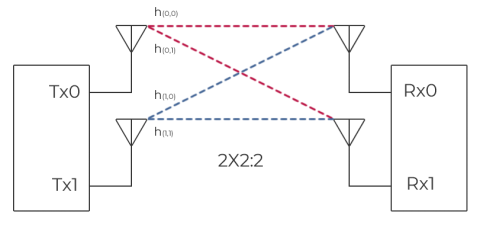2x2 MIMO
What is 2x2 MIMO?
2x2 MIMO, sometimes referred to as 2T2R, uses two antennas to establish up to two streams of data with the receiving device. Compared to ordinary single antenna networks, 2x2 offers up to a 100% increase in throughput.
With two spatial streams established, the data payload is divided across both antennas and transmitted over the same frequency band. In order for spatial multiplexing to be effective, the antennas must be well isolated and configured to provide a low correlation coefficient. Typically the most effective way to achieve low correlation in a 2x2 system is to use orthogonal polarisations, for example, using one vertically polarised antenna and one horizontally polarised antenna.
Of course in many UE systems totally orthogonal polarisations are not possible, in which case the concept of Envelope Correlation Coefficient (ECC) comes into play. ECC accounts for characteristics such as 3D radiation patterns and phasing to determine how independent the two antennas are of each other. Ultimately practicality forms an upper limit to antenna performance as both antennas must be enclosed in a single device or installed in a small amount of space.

2x2 MIMO Performance
Under laboratory conditions the theoretical maximum performance increase is 100%, i.e., doubling the downlink throughput, representing the ability to transmit two totally uncorrelated streams of data. In real world conditions antenna isolation and correlation are not perfect, in which case 2x2 MIMO performance is determined by the physical transmission environment. Spatial multiplexing requires independent transmission paths and in lieu of uncorrelated antennas independent paths can be provided by scatter, where reflections off a building or terrain feature between the base station and receiver provide a unique path not subjected to interference from the first path. It follows that transmission environments with a higher number of distinct paths (higher scatter) permit higher peak data rates.
Intuitively we also recognise that rich scatter environments ordinarily pose a significant problem to signal quality. Literature review confirms that 2x2 MIMO performance is positively correlated signal to noise ratio - in environments with high scatter but very low SNR, such as transmitting through dense vegetation, the benefit of MIMO is minimal.
However in environments with high scatter and high SNR, such as urban and city environments where reflections of buildings are clean, 2x2 MIMO has a very significant benefit.
![Poor Scatter vs Rich Scatter environment [1]](/sites/default/files/2020-02/poor-scatter-vs-rich-scatter-mimo-environment_0.jpg)
2x2 MIMO Antennas
Many manufacturers offer combination antennas designed with both MIMO elements enclosed within the one radome. This approach has the advantage of simplifying installation and many good quality manufacturers will test for ECC and Inter-Port Isolation during the design or manufacturing process.
The clear downside is that physical antenna separation, often key to reducing path correlation, is limited to the size of the radome. The suggested minimum physical separation of two UE antennas in a MIMO system is 0.5 λ, and ideally 2 λ.
2x2 remains a popular configuration for low band (450 to 960 MHz) cellular networks. When building your next system it's important to note the rapid transition to 4x4 and Massive MIMO systems, leaving any 2x2 MIMO equipment outdated. Our company specialises in the development of high performance antenna systems for 4G and 5G networks. If you need assistance finding equipment that will meet the demands of rapidly changing cellular technology get in touch with our team today.
References
[1] Joshi, Sunil & Gupta, Deepak & , Bapna & Kothari, Neha & Suthar, Rashmi. (2011). Throughput Performance of 2X2 MIMO LTE Downlink in a Spatial Correlation Based Microcellular Channel for Wireless Broadband Networks. International Journal of Wireless & Mobile Networks. 3. 151-159. 10.5121/ijwmn.2011.3512.